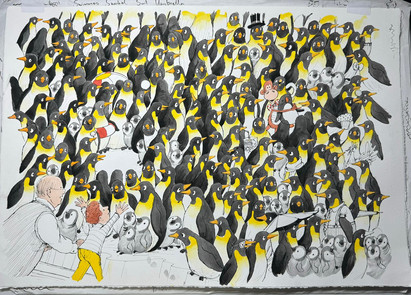Sam Usher ~ mess & books!
- armadilloeditor
- Sep 17
- 5 min read
I’ve had two books released over the last few months, CLANG - the second title in my new quartet, following ZOOM which came out last year – and Adventures with Grandad, a bind-up of my Seasons’ quartet and a celebration of 10 years publishing these stories about Boy and Grandad. Clang! is about a Boy and his Grandfather on a hunt for Boy’s lost toy, which takes them all around the world. I’d love to tell you about how I make my books. It's quite a long winded and messy process — I don’t use a computer at all — it’s all pencils, gouache paints, and Indian ink, and piles and piles of paper.
I’ll start with just about the most pretentious thing I have ever said, but the idea for CLANG came to me when I was on a book tour in Florence, Italy. I was sitting in my favourite café doodling in my notebooks — I’d just finished my previous series about animals (FREE, WILD, LOST and FOUND), which were a follow up to the seasons series (SNOW, RAIN, SUN and STORM) — and wondering what on earth to do next. What groups of four words sounded good together? PLUCK, STRUM, TOOT, HUM, a series about musical instruments? ZOOM, CLANG, WHOOSH, BANG, a series about making things? That could be fun!
ZOOM was clearly going to be about a space rocket, but what about CLANG? I wrote a draft where the Boy wakes up in the morning, and the whole house is FREEZING! SO Boy and Grandad go on a mission to fix the logburner, which turns into some sort of steam train… maybe that would work? But I didn’t like the associations with pollution and global warming.
So how about the clang of a ship’s anchor? Yes! Then I get to draw my favourite thing – stormy seas and pirates. Perhaps Boy and Grandad go on an ocean adventure… but why? Every story starts with a problem that needs to be solved, so I needed to be terrible and make a problem for Boy. What is worse than losing your favourite cuddly toy as a child? Now we have the basis for a story.
The first step is to draw a pile of thumbnails – postcard-sized sketches — of the 16 double-page spreads of the book. I use a cheap fountain pen with waterproof ink, which means I can do watercolour washes over the top of the drawing. I do all my drawings on watercolour paper that is quite thick – almost like card, allowing it to soak up the watercolour paints without warping.
Usually, picturebooks are 32 pages, but for some reason mine are 40, which works out at 16 double-page spreads. I like to make my thumbnails physically so I can lay everything out on my desk and make edits by shuffling things around. The writing process is physical, which helps beat writers’ block.
It’s then time to turn the tiny postcard sized drawings into full-sized pencil layouts. I add in characters, background details, set dressing, and usually try and sneak in some details from my favourite books. See if you can recognise any of them… Tintin, Quentin Blake, etc. The pencil layouts are still rough since it’s all about planning the layout of the page rather than making a finished drawing. Scribbly lines everywhere. This is probably my favourite bit. I draw this stage on light layout paper so I can trace things when I go wrong, cut things out and stick it all together exactly how I want.
Now it’s on to the stressful bit – final artwork. These are the materials I use:
Watercolour paper – Saunders Waterford HP 300gsm
A light box to illuminate the pencil layouts through the heavy watercolour paper
An old victorian nib and pen holder
Indian ink for the lines
Gouache paint for the colours
I use the pencil layouts as a guide to show me where the elements of the picture should be. It’s important to keep the drawing alive – the line nice and loose, the characters with a glint in their eye. I sometimes draw 3 or 4 of the same picture at once so I’m not too stressed about going wrong. I’ll give myself a day to do a double-page spread, half a day to draw a single page. I change into my joggers, put on a scruffy old hoodie covered in paint, stock up a bowl of chocolate on my desk, and sit drawing in a sort of daze for a few weeks until all the line is done. Plenty of mistakes along the way, but I just try again.
When all of the line is finished I upload it to show my editor and art director – it’s a very collaborative process. I get their thoughts, then start on the colour. For double-page spreads, I’ll work entirely on that image for a few days. For vignettes – for example of the Boy and Grandad looking for penguin and making their boat, I’ll pile up the drawing and have a little production line situation going on. Do all the skin tones, jumpers, trousers, hair, etc. One colour at a time, then using pinks or bluey washes, I’ll suggest backgrounds and environments.
It’s crucial when adding the colour washes not to be too heavy-handed — I want the washes to dance around the line – not just flump on top of it – so I leave white space between the line and wash where light would fall on the object I’m drawing, and my favourite thing about gouache is that (unlike watercolour)when it’s dense enough it becomes opaque, so I get to use both of these qualities in my pictures – light and transparent in light areas, and toward shadows I allow the paint to pool, which causes it to dry darker in unpredictable ways. I’m using the physical properties of water to suggest the organic ways light falls over objects and how it plays on surfaces.
I’ll go a wrong a few times, drop chocolate or paint all over a piece, and have to do it again. Finally, it’s time to upload everything again, get feedback from editor and art director and if they like it, wrap everything up in an A2 folder, take it to the post office and then cross my fingers it arrives. The whole book from start to finish usually takes 5 to 6 weeks, with a month or so tying up loose ends and adding little bits in once everything is handed in.
And that’s about it! Illustrating is great fun and I can’t wait to get on with my next one. I hope everybody enjoys CLANG and Adventures with Grandad.
Clang! by Sam Usher, out now, published by Templar Books
Adventures with Grandad, out now, published by Templar Books

.jpg)



















































Comments